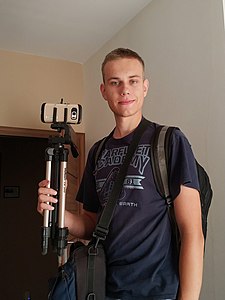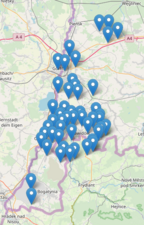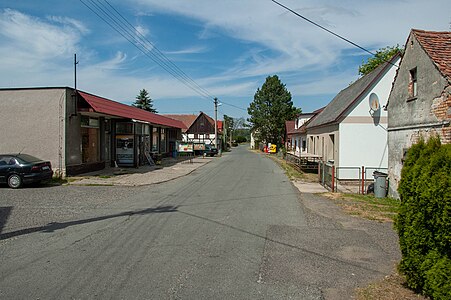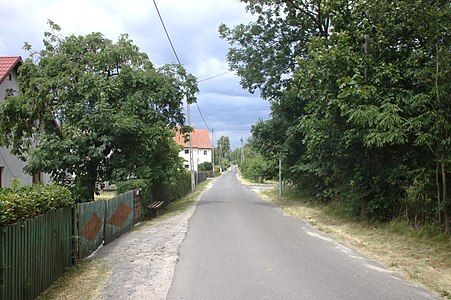Wikipedie:Wikiexpedice/2019/Dolní Slezsko/Závěrečná zpráva/en
Wikiexpedice Lower Silesia was a multi-day group photo session that took place in July 2019 in the west of the Lower Silesian Voivodeship in Poland and partly in the Czech Republic in the Frýdlantský výběžek. Below is a detailed final report on the event, which was mainly to illustrate the articles of villages on Wikipedia. Overall, the event was successful and we brought thousands of new photos, which now illustrate hundreds of articles on Wikipedia, but also items on Wikidatech. Problems still persist with the speed of uploading photos and placing them in Wikipedia. By the next Wikiexpedition, we would like to create tools that would help with this agenda, or link the action to the editaton. Funding has also proved to be a problem, including uncertainties in billing. In general, funding from various sources appears to be time-consuming. The event was financially supported by Wikimedia Poland.

Basic information
[editovat | editovat zdroj]- Location: west of Lower Silesian Voivodeship, Frýdlantský výběžek
- Dates: 3. – 7. July 2019, another photoshoot 8. – 10. 7.
- Organizer: Juandev
- Financial support: Wikimedia Poland, own resources
- Participants: 5 photographers (Aktron, Art Jarka, Juandev, KKDAII, MIGORMCZ); at least 5 others have been involved in enhancing or sorting photos online
-
Group photo, Wojcieszow, Poland
-
Before the event
-
Photographing
-
Return to the car
-
Evening photo processing
Objectives and results
[editovat | editovat zdroj]Wikiexpedition's goals could be divided into main and secondary. The main goals were the acquisition of photographic documentation of non-photographed settlements and the placement of photographs in Wikipedia.
| Description | Goal | Results | Notes |
|---|---|---|---|
| Newly photographed settlements[N 1] | 150 | 115 | The lower number of settlements taken than the plan could be explained by the lower number of participants and the lower number of days of the event. The original event counted with eight people and 3.5 days. In the end, only 5 photographers took part and some of them spent only 2.5 days at the event.
In addition to 115 newly-photographed settlements, we also photographed other objects, cities, and items on Wikidata. We photographed five villages in the Czech Republic. |
| Number of photographs | 2800 | 5700 | A significantly higher number of photos than the plan is attributable to taking photos in the towns and to the fact that most photographers took pictures of one village. While the Czech villages are small, they can be photographed by one photographer, most of the Polish villages are large, and therefore more photographers at the same time photographed them. This then raises the number of photos per settlement and the total number of photos. |
| Usage (in Wikipedia) | 20 % | 22 % | Most of the articles were illustrated on Polish Wikipedia (about 150), while most photos from the event went to English Wikipedia (430). We placed 255 photos on Czech Wikipedia and illustrated about 70 articles, of which nearly 50 were newly written. Many of the photos were placed on Wikidata also. |
-
Map of photographed sites East
-
West
-
Uploading progress over time
-
Usage
|1| The maps on the left show two locations where Wikiexpedition participants shot missing villages. After the experience of previous years, when there were overlaps during the shooting of individual teams, this time the system of shooting places in opposite parts of the sector was chosen. Participants were free to choose how they were assembled into teams. |2| The middle graph shows the number of photos uploaded over time. During expeditions, we try to have the photographers upload as soon as possible, so we give a deadline of three months to upload. The reason is that with the passage of time the photographer forgets what he/she took and so the whole set is subsequently difficult to process. In the case of Wikiexpedition Lower Silesia, most of them uploaded in the deadline (hence the increase in the third month). As a result, everyone uploaded their photos. |3| When inserting photos into Wikipedia, not only Polish Wikipedia was illustrated, but also other language versions (some of them, such as German or Arabic, however, participants did not add their photos due to the language barrier). Of the European languages, most articles have been illustrated in Polish, Ukrainian, English, and Czech. Many articles from non-European languages were illustrated on Cebuano Wikipedia. In the case of Czech Wikipedia, less than 50 new articles were written.
Six most used photos
-
Białopole (PL) 8x
-
Višňová (CZ) 7x
-
Jastrowiec (PL) 7x
-
Gorzanowice (PL) 5x
-
Koźlice (PL) 5x
-
Przesieczany (PL) 5x
-
Posada (PL) 4x
-
Komarno (PL) 4X
The secondary goal was to advocate Wikipedia as a good source of information and increase the number of contributors. If we encountered questions about the purpose of the photo shoot, we explained the purpose of the photo shoot and gave it them reminder bookmark of Polish Wikipedia. After years of organizing Wikiexpeditions and other group edits like editatons, some invited externalists are themselves contributors to Wikimedia projects.

Findings
[editovat | editovat zdroj]Since it was not the first Wikiexepedition we organized, not even the first in Poland, the terrain was not such a surprise for us. We already know from Wikiexpedition Silesia held in 2016 that there are some differences in rural areas in the Czech Republic and rural areas in Poland. In Poland, the distance between villages is bigger, which may result in fewer villages photographed per day, but on the other hand, it brings more photos per settlement. Moreover, most of the participants were able to speak Polish in some way, so there were no problems in terms of the language barrier. Problems did not make the underlying maps in which several coordinates were wrong. In terms of the organization of work on-site, the teams also tried the work of four photographers at once, which proved feasible. However, the fourth day on which such a photographing took place was disrupted by a puncture on one of the car's wheels. At that moment, it proved to be very good that there were two cars at the event. The second car took the participants from the villages and the first was repaired meanwhile.
There was no serious problem in terms of uploading photos and basic categorization. Again, we used the overview tables with links to Wikipedia and the Wikimedia Commons categories, where we rewrote individual sites, as they were taken from the papers supplied by each team leader. The speed and quality of processing vary from participant to participant. Some have excellent photos, others worse. Some add more information to others less. In the action of this format, we only require the correct identification of the main object, i.e. the village (town). If we wanted to improve photographs, it would be worth considering to buy better, but at the same time user-friendly cameras that could be used by participants who do not have better technology. It would also be worth considering equipping each team with a drone. Some objects are difficult or unavailable for various reasons and the drone would speed up the work and allow sufficient shooting. It could also be used for photographing details of architectural monuments.
Adding photos to Wikipedia was again a problem, most of the participants did not do so and so the organizer had to do so. There is a solution in the form of application or software development that would significantly speed up the process of processing file descriptions, but also their placement on Wikidata or Wikipedia. On the other hand, an interesting idea arose to follow up on Wikiexpedition by the editaton, which would create articles for the photographs taken. This could not only result in the desired placement of photographs in Wikipedia, but also in the secondary identification and use of more photographs.
From an organizational point of view, Wikiexpedition remains a time-consuming action. Most of all it takes the preparation of data and eventually post-processing of photos. For the first time last year's Wikiexpedition, we made significant use of Wikidata querying and generated lists of all settlements in the region, which we then filtered manually to identify the sites that need to be photographed. Wikimedia Poland helped us, specifically Yarl, with the query. The help of Wikimedia Poland, the main sponsor of the event, has also been useful in other areas, such as communication with the hotel and the payment of accommodation directly, and partial internal PR. Unfortunately, there was a problem with project billing. On one hand, the organizer miscalculated the budget, on the other hand, it was not very clear how to fill in Polish travel documents, there were communication problems and the billing was delayed. This led to a disproportionate burden on the organizer, especially in the financial area, where he had to finance many things from his own. From long-term experience, it seems that financing such events from chapter grants unnecessarily burdens the organization of the event. On one hand, chapters do not have good standardized procedures for such events for which they are larger in terms of numbers, and on the other hand, getting to know the methods of billing in different chapters gives extra work for the organizers. Although it does not seem, the billing method is important to plan the entire event, and the billing method varies between chapters.
Budget
[editovat | editovat zdroj]The main sponsor of Wikiexpedition Lower Silesia was Wikimedia Poland, part of the expenses were covered by the organizer.
The table below compares the originally approved costs with the actual situation. Individual amounts are in euro. For the conversion from the Polish zloty was taken exchange rate 1 zloty = 0.23 euro valid as of 9th March 2020.
| Expenditure item | Approved costs | Actual costs | The organizer paid | Notes |
|---|---|---|---|---|
| Transportation | 659 | 351 | 19 | The reason for lower transport costs is certainly less number of participants, but also the closer location of accommodation, which was not known at the time of submitting the grant application.
A part of the transport costs was paid by the organizer due to billing problems. |
| Accomodation | 399 | 450 | 0 | The reason for higher accommodation costs than the approved budget was because the organizer had an error in the original draft budget. Instead of the required 32 nights, he had only 16 in the budget.[N 2] Another problem arose when the hotel was paid for by the chapter[N 3] and then the two participants did not appear. Although the organizer addressed about 20 potential wikifotographers from Poland, the Czech Republic, and Germany, he was not able to occupy these places again. |
| Alimentation | 193 | 290 | 141 | The original application was 154 euros, WMPL adjusted to 193 (?) And approved 193. When paying accommodation also WMPL paid for breakfast, which was quite expensive and cost about 10 euros per person. Due to protracted billing problems, the organizer decided to pay the subsistence fee of 8 euros per day and the participant according to the original model. |
| Other | 110 | 59 | 59 | Includes map documentation, on-site puncture repair and part of the insurance.[N 4] The rest was paid by the participants themselves. It was not billed to Wikimedia due to billing complications. |
| Total | 1361 | 1150 | 219 |
A table of other expenses that were not reflected in the Wikimedia Poland grant application but had to be made.
| Expenditure item | Payed | Who | Notes |
|---|---|---|---|
| Mobile phone for team B | 246 | Organizer | In the end, because the printed documents were not prepared due to the wrong coordinates and they cannot be corrected in time, a good-quality phone was purchased for team B to navigate between points of interest. |
| Repair of the car | 98 | Organizer | Necessary to repair the car for use in a longer event in a foreign country. |
| Total | 344 |
We did not exceed the original budget request submitted by Wikimedia Polska but was about EUR 195 lower. Other costs must always be taken into account because they cannot be predicted.
Notes
[editovat | editovat zdroj]- ↑ In this sense, newly photographed settlements are villages that do not have two or more photos or have photos, but they are of poor quality.
- ↑ The reason for submitting the wrong budget was that the organizer did not check the budget and was quite overloaded. Wikiexpedition Lower Silesia was preceded by Wikiexpedition Dolni Vozice, which had the same organizer. For the next time, it seems appropriate to let the budged be checked by another person, or the actions have been aggregated into one grant. At the moment the problem was detected, the problem was communicated with Wikimedia Poland.
- ↑ The original requirement was only to pay bail. However, Wikimedia Polska has paid the full price. It is precise because of the possibility of dropping out of one of the participants that we try as organizers to pay for accommodation never in advance.
- ↑ The maps were available to the participants as blind at a sufficient magnification, that every participant can prepare himself/herself its own way.

















